Sindh Water Policy


Background : The Sindh Water Policy, in alignment with the National Water Policy (NWP) formulated and approved in April 2018, serves as a comprehensive framework and guiding document for water management and development in the province. The NWP establishes a broad policy framework and principles to ensure water security, providing a basis for the Provincial Government to create their individual Master Plans and projects for water conservation, development, and management. In accordance with the NWP, the Federal Government, represented by the Ministry of Planning Commission, has advised all signatory Provinces, including Sindh, to develop their own water policies by March 2022.
Goal : The goal of the Sindh Water Policy is to effectively manage and develop water resources from all available sources, including surface water, groundwater, wastewater, the Indus Delta, wetlands, and arid regions. This management aims to ensure the sustainable use of water for the prosperity of the people of Sindh. The policy focuses on meeting the social, economic, and environmental needs of the province while safeguarding water resources for future generations
Introduction : The Sindh Water Policy aims to address the major concerns and issues related to water in the province. Sindh, being the second most populous province of Pakistan with close to 50 million people, heavily relies on water for socio-economic development and livelihoods. However, the available water resources are limited, with mean annual rainfall ranging between 100 and 200 mm. The main source of water in Sindh is the Indus River, which is diverted through an extensive hydraulic infrastructure. The province faces multiple challenges, including reduced surface water inflows as a lower riparian, uncontrolled flood releases during flood periods, and deteriorating water quality in the Indus River. Climate change exacerbates the situation, leading to increased frequency and intensity of droughts and floods, affecting agriculture, livestock, and coastal areas. The population growth and migration from rural to urban areas further strain water resources, creating higher demands for potable water, industrial use, and sewage management. The Sindh Water Policy seeks to address these challenges by emphasizing sustainable water use, improved spatial planning, flood resilience, and equitable water access and decision-making.
The mission of the SWP is to ensure integrated water resources management by establishing robust institutional arrangements and implementing effective actions based on principles such as accountability, decentralization, participation, resilience, and transparency.
The vision of the Sindh Water Policy (SWP) is to achieve inclusive development and effective management of water resources in Sindh, promoting the well-being of its citizens, society, and economy.
The SWP objectives are to establish clear policy directions and action plans for active water management, ensuring long-term safe usage of water resources through robust institutional arrangements. This will greatly contribute to Sindh's inclusive development, safeguarding citizens' well-being and preventing water service deficiencies.
The SWP guides ecologically sustainable water management in Sindh, aiming to prevent water resource degradation, ensuring ecosystem sustainability, enhancing resilience to floods and droughts and maximizing economic benefits.It acknowledges complexity, considers various factors, and emphasizes adaptability to changing values and advancements.
Honourable Chief Minister Sindh accorded the permission on the Summary floated by Irrigation Department, Government of Sindh on 1st April 2019 to start the preparation of Policy through formation of following setup:
Steering Committee (SC) notified on 5th September 2019 under the Chairmanship of Minister Irrigation to provide overall guidance on policy objectives and targets and to monitor formulation progress.
Inter-Departmental Technical Committee (ITC) notified on 6th July, 2020 under the Chairmanship of Secretary Irrigation to discuss and formulate policy and recommend steering committee policy options and review and endorse background studies required for policy preparation.
Drafting Group (DG) formed comprising of leading water resources experts (one international experts supported by two local experts) to draft a policy under overall guidance of the Committees.
Revision Group (RG) constitutes the Sindh Irrigation Department Chief Engineers already engaged in dealing the Policy matters within Sindh and on transboundary level monitored by the Secretary Irrigation Sindh
The Final Draft of the Sindh Water Policy was presented to the Sindh Cabinet for approval, and after thorough discussions, it received approval for adoption.
Various consultative workshop/dialogues/seminars on formulation of Sindh Water Policy have been held.
During these event, large numbers of experts / professionals from various offices/organizations, farmers, women of public and private sectors and media personals participated and shared/provided their views / comments & suggestions/ recommendations.
Throughout the world, governments and water users’ institutions are trying to come to grips with the concept of sustainability, for management of specific resources - surface water, groundwater and wastewater.
Ecologically sustainable management and development, in terms of surface and groundwater resources and the deltas.
A set of four Policy Reform Areas, as Component Policies, are developed, identifying management and development needs and opportunities and providing clear management and development principles and guidelines.
They will commit agencies to review and modification of related regulatory and operational activities, and to the support of cooperative/collective management and development programs. The component policies included in the Sindh Water Policy are:
1) Water governance including restructuring of present Irrigation department with Institutional strengthening and reforms under newly envisaged Sindh Water Resources Management Department (SWMO) with broader mandate of Planning, Managing and Developing all water related physical resources of the province of Sindh including research based future development.
2) Management of water quantity
3)Protection of water quality
4)Management of water dependent ecosystems
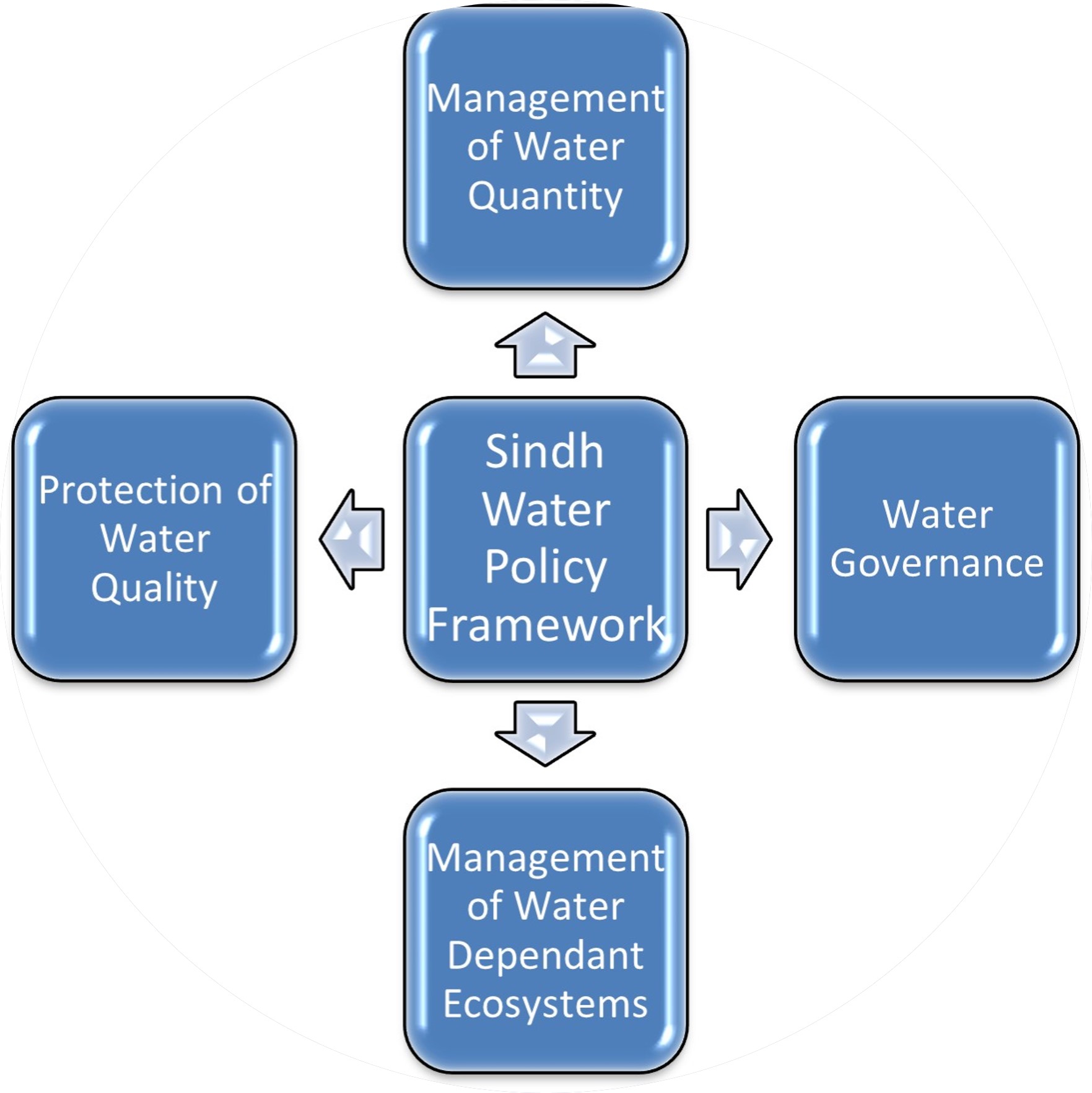
The IWRM approach has been adopted for the formulation of Water Policy Framework for Sindh,which is based on four major principles covering:
a) water as a limiting and scarce resource therefore adoption of basin approach is essential;
b) participation of all stakeholders;
c)gender perspective; and
d)water as a social and economic good.
How a basin approach will be adopted in a wider ecological diversity is a serious concern? For example, Barrage command can be taken as a river basin, and each of the canal command can be taken as a sub-basin. In all other ecosystems, approach of river basin or sub-basin will be used
Development of surface and groundwater resources must have to be seen within the overall Basin Management Plans (BMPs) to ensure sustainable development Basin Management Plans
Out of fourteen (14) canal commands, three AWBs have been established on three (03) Canals under the legal framework of Sindh Water Resources Management Ordinance 2002 in the province.
In each of the AWB, FOs are not yet fully functional. The FOs are still not capacitated. However, role of FOs and WCAs have to be modified to fully cover the aspects related to groundwater and wastewater.
In rest of elevan (11) Canal Commands, the canals are being managed by SID under the Sindh Irrigation Act of 1879
Thus, there are two parallel systems in practice within the Province for the management of Canal Irrigation System. The dual system of managing canals will not lead the province anywhere.
There is a need to evaluate success and failures of reforms and then take policy decision for further adoption and making these reforms more effective.
Review in consultation with concerned organizations the progress in controlling pollution of water bodies including rivers, streams, lakes and groundwater, canals, wetlands.
Decision must be taken to bring reforms artery within the Water Resources Management Department (SWMD) and work conjointly within all Canal commands of the province.
The policy reforms under each of the component policy means that the level of management applied to each of the provincial surface and groundwater basins/sub-basins commensurate with the potential threat being faced by a particular basin/sub-basin. The range of management instruments include:
Basin management plans covering all sources of water (surface, groundwater and wastewater) and all sub-sectors of water use (domestic, agriculture, industry, commercial and environment) – Barrage command will represent a basin and canal command is taken as a sub-basin; whereas river basins is used for areas outside the canal commands
Land use plans for all sub-sectors - urban, agriculture, landscape, industry, river basin, infrastructure, etc.
Water development plans for surface and groundwater for all land uses – wetlands, Indus delta, Indus basin canal commands, Kohistan and Kirthar range, right side of the Indus river, Thar desert, and riverine areas
Agricultural water productivity enhancement innovations – wetlands, Indus delta, Indus basin canal commands, Kohistan and Kirthar range, right side of the Indus river, Thar desert, and riverine areas
Domestic water, sanitation and water treatment plans – urban centres, towns and rural areas
Supporting guidelines for irrigation, agriculture, forestry, local government and industry;
Spatial and temporal databases and mapping - water availability, aquifer potential, current use, balance available for further development, wastewater and treatment options, and vulnerability mapping
Awareness and education strategy
Legislative mechanisms for surface water, groundwater and wastewater management
Licensing tools and conditions for surface and groundwater users better reflecting resource protection objectives, and
Social and economic instruments applicable to surface water, groundwater and wastewater management.
Sindh’s Water Policy will be consistent with the aims of the;
Pakistan Water Apportionment Accord of 1991,
National Water Policy, Irrigation Act – Amended 2022, SWMO 2002,
National Water Quality Standards, and National Water Sector Strategy of 2012 including the water reform agenda,
Provincial/National policies on drinking water, sanitation, wetlands, forestry, rangelands, etc.
The policies and practices will be in line with the provincial government directions for the management of natural resource, as envisaged in the Sindh Strategy for Sustainable Development of 2007.
Six key policy reforms related to water governance including institutional reforms are identified;
Water governance in the province is weak in many respects covering aspects of indiscipline, lawlessness and break of communication system for O&M of canal irrigation system.
Since 1971, the Irrigation Department Sindh is engaged in the development of Physical Water Resources of Indus River, Hill torrents, Surface water storage for multipurpose arid zone development, fresh water supplies through pipelines in Thar desert, supplying the ever-increasing needs of Karachi metropolitan city and other cities in province,
Research and development and water for industry like; supplying water to Thar coal reserve power plants and the management of Groundwater through SCARP & LBOD tube wells and surface drains.
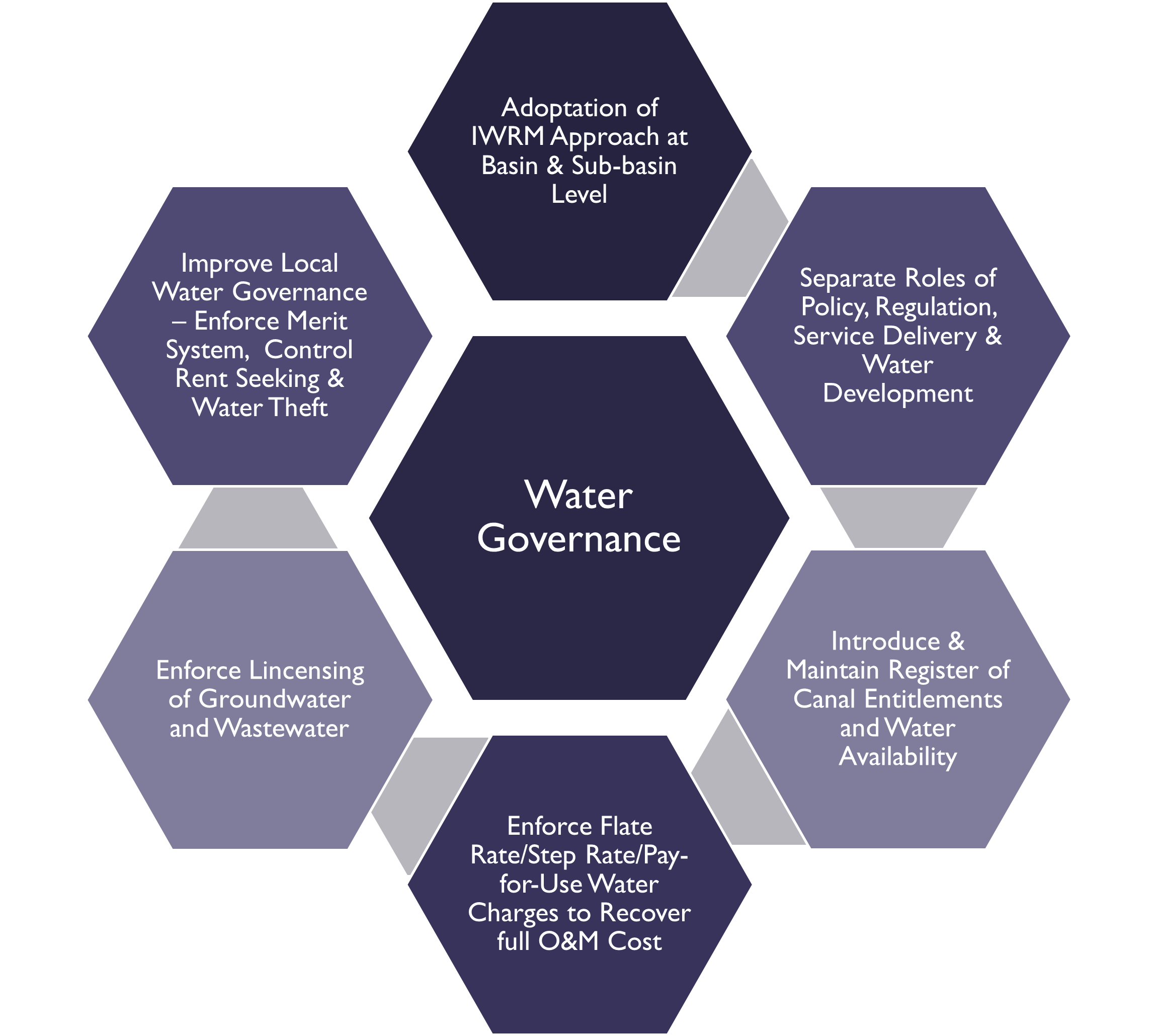
First Policy Reform: Adoption of IWRM approach at the basin or sub-basin level covering all sources of water (surface water, groundwater and wastewater) and all sub-sectors of water use (domestic, agriculture, industrial, commercial and environment)
Second Policy Reform: Separate roles of policy/regulation, service delivery, water management, and water development through restructuring of SID & SIDA into a Sindh Water Resources Management Department (SWRMD) and introduce reforms in the associated institutions.
Third Policy Reform: Introduce and maintain register of canal water entitlements and actual availability of water at all levels including the Mogha command and introduce water conveyance loss function in Warabandi formula to improve water equity in volumetric terms
Fourth Policy Reform: In first phase, enforce Flat Rate of Abiana based on the farm command area (whether cultivated or not). Looking to the declining trend in the availability of Water, in the second phase, working paper for implementation of the Step Rate system be prepared for discussion and approval of the Provincial Water Council to encourage conservation of water and to charge those who use excess amounts of water for producing high delta crops like rice, banana, gardens etc. The Step Rate of water terrif recovery employs progressively higher charges for bands of consumption. Thus, the initial band will be a volume sufficient for subsistence farming needs and charged at the minimum rate. Increased consumption for high delta crop assessed at higher unit charge. The principle of this method is improved recovery of Abiana and introduce phase-wise increase in Abiana to recover the full cost of O&M. For the Groundwater, often a mixture of flat rate, step rate and pay-for-use systems may be preferred to set tariffs for agriculture, domestic, industry and other uses. These systems generally employ low flat rates for a given amount of water and thereafter use a progressive rate for increasing water use. But the groundwater hydrological conditions will still hold the driving seat for the allocation of groundwater use in different areas of the province.
Fifth Policy Reform: Prepare and enforce appropriate legislation for licensing of groundwater in Sindh province, surface water in areas outside the Indus basin canal commands and disposal of treated effluents to improve water governance
Sixth Policy Reform: Improve local water governance through enforcement of merit system in posting and transfers in the Sindh Water Resources Management Department
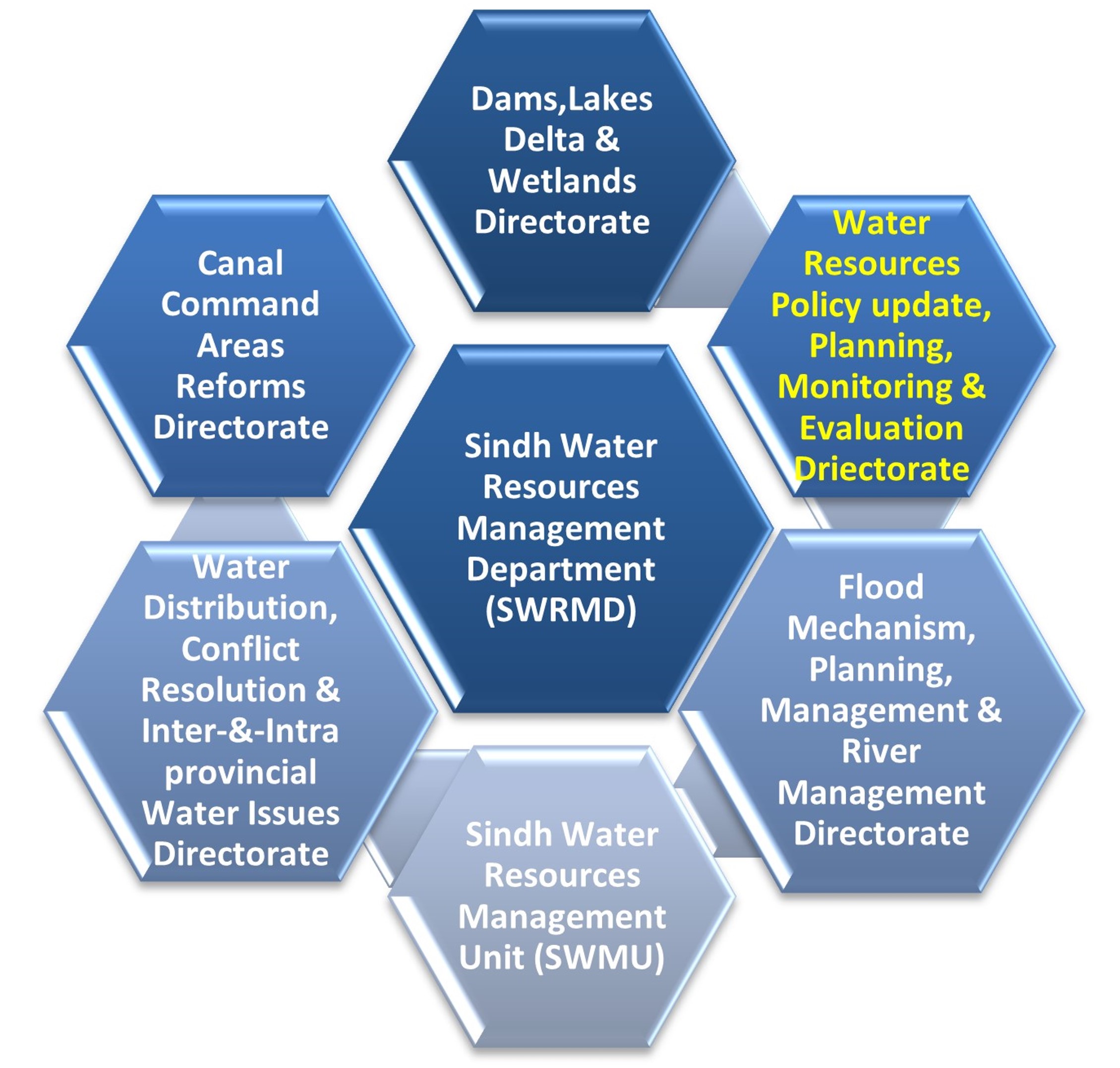
The Sindh Water Council shall be established with the following composition and shall meet at least once a year and perform the following functions:
|
|
||
| 01. | Chief Minister of Sindh | Chairman |
| 02. | Minister for Irrigation | Co- Chairman |
| 03. | Minister for Agriculture | Member |
| 04. | Minister for Fisheries & Livestock | Member |
| 05. | Chief Secretary Sindh & Livestock | Member |
| 06. | Chairman P&D Board | Member |
| 07. | Secretary Agriculture | Member |
| 08. | Secretary Local Government | Member |
| 09. | Secretary Fisheries & Livestock | Member |
| 10. | Secretary Irrigation | Member/Secretary |
| 11. | Two Experts from Academia | Member |
| 12. | Any other co-opted Member | Member |
Review and coordinate implementation of the Sindh Water Policy and periodic updating of the same.
Recommend legislation, policies and strategies for water resources development and management.
Planning and coordination for water resources development and management activities at provincial level to achieve objectives of policy.
Review all major provincial water-related projects and activities in the fields of irrigation, drainage, flood control and hydropower.
Promote multi stakeholders' participation and integrated water resources management.
Review in consultation with concerned organizations the progress in controlling pollution of water bodies including rivers, streams, lakes and groundwater, canals, wetlands.
Coordinating water resources database service at different level.
Any other function for water resource development and management.
The Sindh Water Resources Department will serve as the Secretariat of the SWRC.
The proposed Implementation Committee, responsible for executing the Sindh Water Policy, will consist of the following composition. The Committee will meet at least twice a year, and more frequently if necessary, to monitor the policy's implementation progress.

|
|
||
| 01. | Chairman P&D Board | Chairman |
| 02. | Secretary, Irrigation Department | Co- Chairman |
| 03. | Secretary, Fisheries & Livestock Department | Member |
| 04. | Secretary, Agriculture Department | Member |
| 05. | Secretary, LG Department | Member |
| 06. | Secretary, Environment Department | Member |
| 07. | Secretary Energy Department | Member |
| 08. | Secretary, Industries Department | Member |
| 09. | Secretary, Forest Department | Member |
| 10. | Secretary Education | Member/Secretary |
| 11. | Director General, PDMA | Member |
| 12. | Three renowned water experts | Member |
| 13. | Any other co-opted member | Member |
First Policy Reform: Develop and introduce cost-effective and efficient O&M system for canal irrigation and water resources infrastructure to ensure equitable distribution of water in volumetric terms by reducing water conveyance losses and effective conservation of the surface & groundwater.
Second Policy Reform: Foster full participation of water users in operation, management and maintenance of irrigation system to ensure equitable distribution of water.
Third Policy Reform: Introduce licensing for the installation of tubewells and wells to ensure safe well spacing and safe abstraction of groundwater considering the site-specificity of aquifer conditions in different ecosystems
Fourth Policy Reform: Provision of knowledge and technical support to water users by the public-sector institutions and private sector for the provision of supplies and services for water use and crop production technology
Fifth Policy Reform: Develop and introduce effective link between FDM, PIM and IWRM for effective planning, management and development of water resources to mitigate the impacts of droughts and floods
Sixth Policy Reform: Enforce a system of separate disposal of sewage, industrial effluents and storm water to ensure cost-effective treatment of three types of wastewaters and use of treated water as a resource and control pollution of freshwater bodies
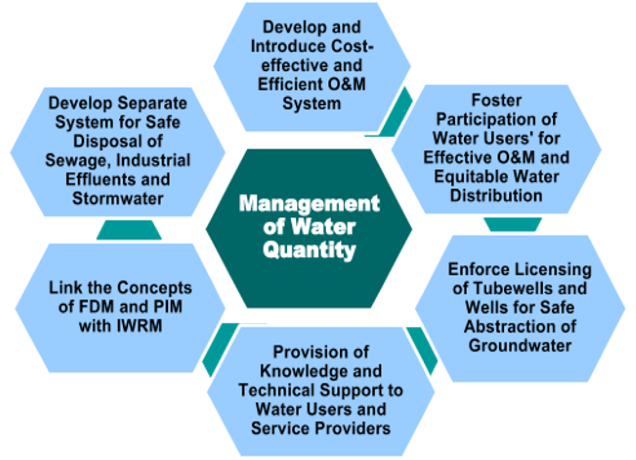
First Policy Reform: Maintain health of the Indus River system through monitoring of surface water quality and enforce legislations to plug the entry of untreated effluents in to the river system.
Second Policy Reform: Develop water quality standards for surface water, groundwater and treated wastewater to ensure disposal of zero-risk treated effluents into the Indus River system.
Third Policy Reform:Develop or refine existing water quality standards for drinking water, stock water, irrigation, aquaculture, and poultry.
Fourth Policy Reform: Ensure effective enforcement of managing the health of surface water and aquifers in the province.
Fifth Policy Reform: Provide knowledge and technical backstop support to municipalities and industries to treat/manage effluents along with enforcement of laws and regulations for not disposing the untreated effluents into the freshwater systems
Sixth Policy Reform: Create awareness and initiate programs for education of civil society to make ‘water as business for everyone’
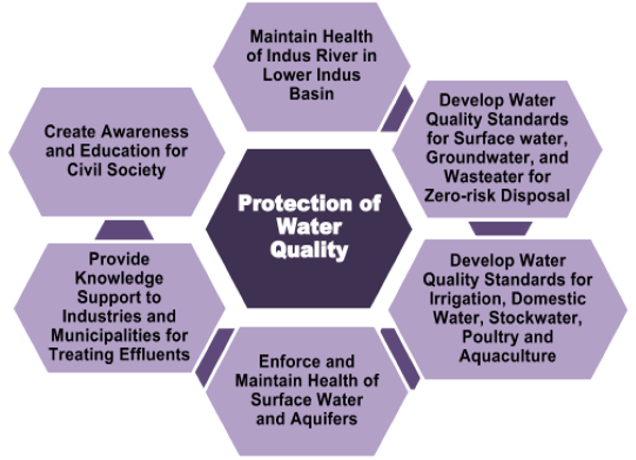
Creating safe places by follwing policy directions:
Addressing hardcore non-access
First Policy Reform: Initiate investigations for water resources assessment in all the water dependent ecosystems considering the local site-specificity using water balance approach at the basin or sub-basin levels covering all sources of water – rainfall, runoff, floodwater from Indus River system in wet years, groundwater, wastewater, etc.
Second Policy Reform: Formulate master plans for ecologically sustainable development and management of water resources in all the water dependent ecosystems to support new livelihoods and restore ecosystem functions through devising most optimal land use system .
Third Policy Reform:Develop, test and adapt innovations for rainwater and runoff harvesting, cascades of water storage, micro-irrigation farming appropriate to specific water dependent ecosystems in areas like right side of Indus, Kirthar range, Kohistan, and Thar desert.
Fourth Policy Reform: Establish appropriate institutional mechanisms for ecologically sustainable development in all water dependent ecosystems.
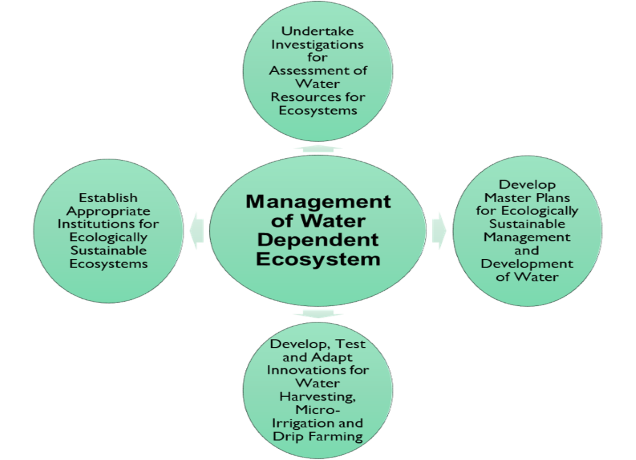
Water management in the drylands/Rainfed Areas
The area of the Indus basin canal commands in the province of Sindh is around 5.0 million ha (12.35 million acres), representing 35% of the geographical area of the province. This means that 65% geographical area of the province lies outside the Indus basin canal command. Number of ecosystems has been identified in the area outside the canal commands and major ecosystems dependent on water are:
a) Wetlands
b) Indus delta
c)Kirthar range and Kohistan
d)Right side of the Indus river and riverine area
e)Small dams; and
f)Thar desert.

Management of Water Dependent Ecosystems
Sindh’s wetlands are generally degrading due to a whole range of human inducted threats including:
a) conversion of wetlands and their immediate surroundings for agriculture and other purposes
b) changes in water flow regimes
c)over harvesting of many forms of wetlands resources
d)felling of timber and deforestation of catchments areas in Kirthar range and Kohistan
e)organic and inorganic pollution of wetlands; and
f)policy deficiencies and inadequate management.
The Sindh province can benefit from wetlands by sustenance for agriculture, grazing and fisheries, provision of vital habitat for wildlife, especially waterfowl, maintenance of water quality and abatement of pollution, flood and erosion control, maintenance of both surface and groundwater supplies, tourism, outdoor education, sports and recreation, and contribution to global climate control and stability.
The key barriers to create an enabling environment remained the lack of effective and integrated policies, absence of decision-making tools and reliable information to support effective wetlands conservation planning, technical deficiencies related to skills and equipment; and the lack of general public awareness or political pressure that favour wetlands conservation.
The most serious concern is the quality of water in the wetlands. SID is by and large a canal irrigation department and having less emphasis on management of water resources and water dependent ecosystems.
The mandate and role of SID in future has to be expanded under Water Resources Management Department, covering all the aspects of water including watersheds, wetlands, Indus delta and deserts.

Management of Water Dependent Ecosystems
Indus delta ecosystem is a part of overall water resources of Sindh and of the Indus basin whole. The ecological sustainability of Indus delta is essential to manage canal irrigated agriculture.
The framework for water dependent ecosystems has to be developed so that Indus delta is managed in an ecologically sustainable manner.
The major thing which will be required in the framework is to change mandate of SID to Sindh Water Resources Management and development so that it can effectively manage Indus delta.
This would also require an integrated approach for developing component policy framework so that water resources and delta is managed in an ecologically sustainable manner.
Sindh’s wetlands are generally degrading due to a whole range of human inducted threats including:
a) conversion of wetlands and their immediate surroundings for agriculture and other purposes
b) changes in water flow regimes
c)over harvesting of many forms of wetlands resources
d)felling of timber and deforestation of catchments areas in Kirthar range and Kohistan
e)organic and inorganic pollution of wetlands; and
f)policy deficiencies and inadequate management.
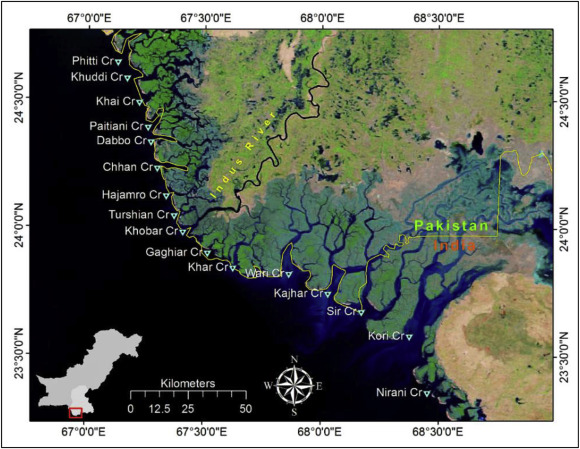
Management of Water Dependent Ecosystems
Spate flows and groundwater irrigation are the two sources of water available in the Kirthar range and Kohistan area. .
Locations for storage of water in small dams and ponds are available and several small dams are constructed but the none of those have the water conservation plan. However, no significant initiative except the construction of Darawat dam has been undertaken in this ecology.
The availability of floodwater from hill-torrents is extremely unreliable because persistent drought is a common phenomenon.
Therefore, cascade of small reservoirs and ponds is a better option than the high dams.
No policy framework is available for floodwater, runoff, storage, conservation and groundwater use management in these areas. .
Along with the policy framework for these areas, there is a need to develop a strategy how surface and groundwater can be managed in an ecologically sustainable manner so that population living in these areas can be saved from out-migration due to persistent droughts.
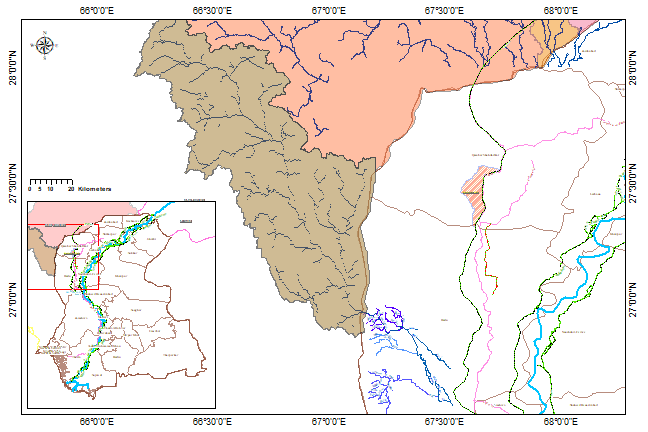
Management of Water Dependent Ecosystems
The areas around the right side of Indus River are high potential areas, as water availability is relatively more reliable than the areas away from the river.
The sources of water in this ecology are: rainfall; river flows; groundwater and Spate flows. The most economical way of exploiting water for agriculture is lift irrigation from river flows; abstraction of shallow groundwater; and Spate flows.
No significant initiative has been undertaken in this ecology except the development of lift irrigation schemes by SID. These schemes performed well until there was subsidy on electric tariff. With the increase in electric tariff, it resulted in deferred maintenance of these schemes and ultimately these become non-functional. The availability of floodwater from hill-torrents is extremely unreliable because persistent drought is a common phenomenon.
No policy framework is available for lift irrigation, groundwater, floodwater, and Spate flows in these areas. Along with the policy framework for these areas, there is a need to develop a strategy how surface and groundwater can be managed in an ecologically sustainable manner.
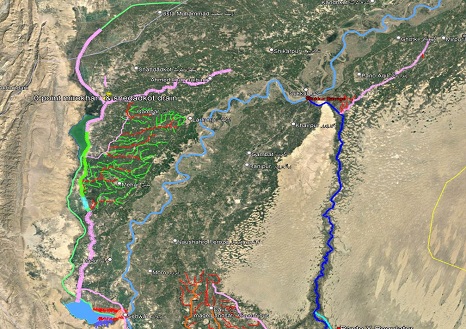
Management of Water Dependent Ecosystems
The current desert farming systems are vulnerable to droughts. Thus, there is a need to develop appropriate desert farming systems which suits local conditions and desert ecology to provide a more sustainable system of livelihood generation.
Government may discourage strategy of allocating large resources to relief measures and focus more on creating opportunities for earning a living with dignity. We should learn lessons from both the earthquake of 2005 and the flood of 2010.
There are serious issues of governance associated with such large dole outs which seldom change the life of the local inhabitants. They may provide minor relief but have no impact on sustainable livelihood.
There is lack of systematic feasibilities and designs of interventions for the management and development of water in the desert. Effective institutional mechanisms are not available and thus new institutional arrangements are needed for effective planning and implementation.
Too many NGOs are involved in studies and surveys without linking it with the provincial development agenda. There are no mechanisms available within the province and in the desert to coordinate the activities of the NGOs and mainstreaming their work with the provincial development agenda.
A wealth of freshwater resources exists in pockets in the desert. Due to rapidly changing monsoonal patterns under climate change water security of Tharparkar will face greater insecurity in the near future.
Droughts and floods will come with greater intensity as evident from the analysis of historical climatic and hydrological data.
Creating resilience with innovative opportunities for future development and management of water resources will address forced out migration.
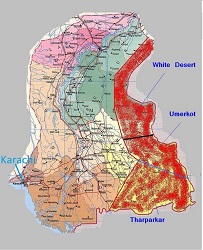
Reporting on water occurs at several different levels, and at a variety of times.
After the formulation of WMAPs, there is a process in place whereby the status of the river basin and aquifer, and the performance of the Plan against its objectives, is reported after every second year.
Plans will be updated every five years, if necessary. In practice only the most highly developed and stressed river basin or aquifers have had this level of review. Surface and groundwater reporting can also occur in the biannual Sindh’s Water Report.
Sindh Water Policy document takes an overview on the health of surface and groundwater across the province.
It is necessary that appropriate resource and environmental indicators are developed and monitored by the Government to reflect the state of surface and groundwater. This work is continuing, and these indicators will then become the basis by which the success of the Water Policy will be judged. This will indicate where adjustments to the Water Policy can be made if the desired outcomes are not being met.
Policy development, coordination and review will be implemented through a stakeholder working group comprising relevant agency and representatives of WRMD.
It is proposed that this working group will report to Sindh Water Resources Management Department.
Once the policies are launched, the group will meet periodically to review policy performance and ensure implementation is progressing.
The policies will be formally reviewed on a five yearly basis. Where WMAPs exist, review and reporting will be through local Water Management Working Committees.
Plans will be reviewed on a five yearly basis and signed off by the SWRMD. WMAPs will be consistent with the broader basin planning objectives and process